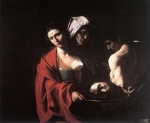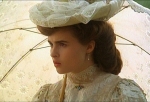 So said film-maker Ismail Merchant, who died on 25 May aged 68. His belief 'in doing things in the most unorthodox manner' made him a genius at raising funds for films like his favourite 'A room with a view', and for 'Howards End' and 'Maurice'. Often derided, 'costume drama' is nowadays a term of abuse, apparently signifying overly lavish sets, the rustle of crinoline and limp romanticism. But for me there is a joyfulness about some Merchant Ivory productions that is out of sync with our predilection for gloom and complaint. Helena Bonham-Carter's Lucy has a passion for life, for Italy and for love itself that puts her at odds with convention.
So said film-maker Ismail Merchant, who died on 25 May aged 68. His belief 'in doing things in the most unorthodox manner' made him a genius at raising funds for films like his favourite 'A room with a view', and for 'Howards End' and 'Maurice'. Often derided, 'costume drama' is nowadays a term of abuse, apparently signifying overly lavish sets, the rustle of crinoline and limp romanticism. But for me there is a joyfulness about some Merchant Ivory productions that is out of sync with our predilection for gloom and complaint. Helena Bonham-Carter's Lucy has a passion for life, for Italy and for love itself that puts her at odds with convention.
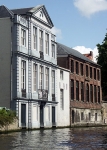
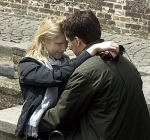 I was in Bruges for a friend's birthday last weekend. After showers we enjoyed the medieval townscape in the just-washed clarity of bright Spring sunshine. Lovers seemd to be everywhere and in the glorious Orangerie it was a little like a Merchant Ivory production. Champagne and smoked salmon from the buffet for breakfast, with a view over the sparkling canal from a richly furnished room in a former convent. Tea from a Georgian silver pot, linen napkins, fresh strawberry and pineapple and little cakes made from the richest Belgian chocolate.
I was in Bruges for a friend's birthday last weekend. After showers we enjoyed the medieval townscape in the just-washed clarity of bright Spring sunshine. Lovers seemd to be everywhere and in the glorious Orangerie it was a little like a Merchant Ivory production. Champagne and smoked salmon from the buffet for breakfast, with a view over the sparkling canal from a richly furnished room in a former convent. Tea from a Georgian silver pot, linen napkins, fresh strawberry and pineapple and little cakes made from the richest Belgian chocolate.
 At the Musée Royaux des Beaux Arts, Brussels I loved the loose brushwork and lightness of this painting by Magritte. In the Arentshuis museum in Bruges are paintings and prints by Sir Frank Brangwyn (1867-1956) – one of those artists whose work seems due for re-evaluation. His painted work is almost frivolously sunny and optimistic, while his prints are wonderfully dark and brooding. Anglo-Saxon dourness and mistrust of the unfamiliar probably lay behind the rejection of his sumptuous 'British Empire Panels' intended for the House of Lords and finally displayed in the Brangwyn Hall in Swansea. A similar dourness and disapproval of anything arty must be the reason why a relative of mine burnt some of Brangwyn's original drawings, given to a family member who was Brangwyn's chauffeur and one of the first licensed drivers in London.
At the Musée Royaux des Beaux Arts, Brussels I loved the loose brushwork and lightness of this painting by Magritte. In the Arentshuis museum in Bruges are paintings and prints by Sir Frank Brangwyn (1867-1956) – one of those artists whose work seems due for re-evaluation. His painted work is almost frivolously sunny and optimistic, while his prints are wonderfully dark and brooding. Anglo-Saxon dourness and mistrust of the unfamiliar probably lay behind the rejection of his sumptuous 'British Empire Panels' intended for the House of Lords and finally displayed in the Brangwyn Hall in Swansea. A similar dourness and disapproval of anything arty must be the reason why a relative of mine burnt some of Brangwyn's original drawings, given to a family member who was Brangwyn's chauffeur and one of the first licensed drivers in London.
One the train home, two young American men with close-cropped hair gazed at each other and kissed and canoodled. Long live unconventionality.
Telegraph obituary for Ismail Merchant
IMDB filmography for Merchant
-
-
'A beautiful life' Gwen John and a family wedding in Wales
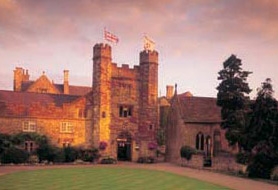 'A beautiful life is to be lived in the shadows, but with peace, order and tranquility' - these words by the painter Gwen John (1876-1939) were quoted at an exhibition about her work and that of her brother Augustus which I saw for a second time this weekend. The show was at the National Museum & Gallery in Cardiff. I was there after an idyllic family wedding at the St Pierre Hotel in Chepstow.
'A beautiful life is to be lived in the shadows, but with peace, order and tranquility' - these words by the painter Gwen John (1876-1939) were quoted at an exhibition about her work and that of her brother Augustus which I saw for a second time this weekend. The show was at the National Museum & Gallery in Cardiff. I was there after an idyllic family wedding at the St Pierre Hotel in Chepstow.
Gwen John's words fit both her work and with my experience of a quietly happy and ordered weekend in Wales. She believed profoundly that her art was integral to her faith, and in her last years produced some remarkable understated portraits inspired by a devotional image of Mère Poussepin, the 17th century founder of an order of nuns near her home in Meudon.
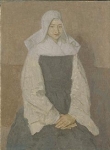 These small-scale, chalky portraits have an austere beauty. John's subjects gaze serenely out of narrowly proportioned canvases in muted greys and browns. After an affair with Rodin, the painter lived out her last years in ordered isolation in a pair of little wooden houses surrounded by green. I heard four young harp students give a recital in the gallery. Mussorgsky's Great Gate of Kiev sounded wonderfully dynamic when performed by a harp quartet, overlooked by a portrait by William Parry of his father John, 'The Blind Harper of Ruabon', (d 1782) sometimes called the father of modern harpists.
These small-scale, chalky portraits have an austere beauty. John's subjects gaze serenely out of narrowly proportioned canvases in muted greys and browns. After an affair with Rodin, the painter lived out her last years in ordered isolation in a pair of little wooden houses surrounded by green. I heard four young harp students give a recital in the gallery. Mussorgsky's Great Gate of Kiev sounded wonderfully dynamic when performed by a harp quartet, overlooked by a portrait by William Parry of his father John, 'The Blind Harper of Ruabon', (d 1782) sometimes called the father of modern harpists. 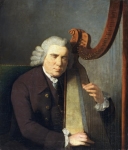
I was delighted by the empty, bright galleries with their collection of remarkable Monets, Renoirs, Cezannes and Sisleys given by the Davies Sisters of Gregynog. Paintings gave glimpses of long dead sitters' lives: the newborn, a family group by Gainsborough, August John's ferocious children, the middle-aged in their prime and Gwen John's serene elderly nuns. I watched the same life stories being told out in Cardiff's shopping streets. In the warm spring sunshine all seemed ordered and peaceful. Even the traffic moved with stately good manners.
Calm good organisation and quiet consideration seemed to mark the wedding, the official start of another couple's life together. It began with a service in the tiny church of St Peter, St Pierre, next to the hotel.
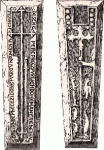 The manor of St Pierre was founded by the Normans and once briefly sheltered the crown jewels. In church the wedding party sat close-by two remarkable 13th century carved tombstones, one of which is believed to commemorate Benet, the church's first known priest. A staff sprouts leaves and is surrounded by wildlife celebrating renewal. Like generations of locals before me I touched the carving's hand that he might bring luck both to me and to the newly married couple.
The manor of St Pierre was founded by the Normans and once briefly sheltered the crown jewels. In church the wedding party sat close-by two remarkable 13th century carved tombstones, one of which is believed to commemorate Benet, the church's first known priest. A staff sprouts leaves and is surrounded by wildlife celebrating renewal. Like generations of locals before me I touched the carving's hand that he might bring luck both to me and to the newly married couple.
Gwen John at the National Museum of Wales
Tate Gallery article about Gwen John -
Caravaggio at the National Gallery

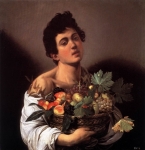 Just 16 paintings in this show, but what an impact they made. I expected the cherry ripe sensuousness of 'Boy with a basket of fruit' (1593-4) but these six dimly-lit rooms focus on Caravaggio's last four years before his death in exile aged just 39, in 1610. Comparison between two versions of the 'Supper at Emmaus', just 5 years apart, showed the transformation from richness and colour to a darker, more humane vision. Caravaggio's stunning chiaroscuro and drama that inspires film-makers like Jarman and Scorsese. In 'The flagellation' of 1607, the tension between Christ's soft submission and the hatred of his scourger is painful to see.
Just 16 paintings in this show, but what an impact they made. I expected the cherry ripe sensuousness of 'Boy with a basket of fruit' (1593-4) but these six dimly-lit rooms focus on Caravaggio's last four years before his death in exile aged just 39, in 1610. Comparison between two versions of the 'Supper at Emmaus', just 5 years apart, showed the transformation from richness and colour to a darker, more humane vision. Caravaggio's stunning chiaroscuro and drama that inspires film-makers like Jarman and Scorsese. In 'The flagellation' of 1607, the tension between Christ's soft submission and the hatred of his scourger is painful to see.
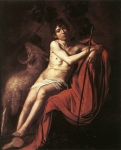 'Saint John the Baptist' of around 1608 had a knowing, sad eroticism that shifted the focus between the saint and Caravaggio's street-boy model. In his last days Caravaggio was a hunted man. He bought his way out of prison and used membership of the Order of St John in Valetta to buy the Pope's pardon.
'Saint John the Baptist' of around 1608 had a knowing, sad eroticism that shifted the focus between the saint and Caravaggio's street-boy model. In his last days Caravaggio was a hunted man. He bought his way out of prison and used membership of the Order of St John in Valetta to buy the Pope's pardon.
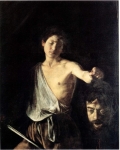 Smooth perfectionism gives way to looser brushwork and less formality. The painter sometimes depicts himself as a hunted creature or as a seeker of absolution, or even (perhaps) as the dismembered head in 'David with the head of Goliath' (1606-10). After this period of intense creativity, Caravaggio died of fever, chasing after the ship that carried away many of his last works. The power and intensity of these last paintings, several of them on a huge scale that would show poorly here, stunned me. Attempts at analysis seemed superfluous. Nothing to do but drink them in.
Smooth perfectionism gives way to looser brushwork and less formality. The painter sometimes depicts himself as a hunted creature or as a seeker of absolution, or even (perhaps) as the dismembered head in 'David with the head of Goliath' (1606-10). After this period of intense creativity, Caravaggio died of fever, chasing after the ship that carried away many of his last works. The power and intensity of these last paintings, several of them on a huge scale that would show poorly here, stunned me. Attempts at analysis seemed superfluous. Nothing to do but drink them in. -
In Brighton and on a train
Just outside Brighton, on Devil's Dyke, the freckled fellow who spontaneously offered me the chance to try out his vast two-handed kite.
In the Lanes, at English's restaurant, the post-stag party that bought us all champagne and an Italian waiter called Tino who made me tea just like he did in Italy, from a teabag and mint leaves. He was all friendliness and spontaneous unprofessionalism and said he'd never made tea like that for a customer before.
On a train back from London, delayed and en route to a replacement bus, a fellow dressed as St George who offered around chocolate cookies. And a slight young Albanian with faltering English and coal-black eyes, who three times offered me his coat as I shivered on the cold bus and on the station platform.
Gratefully I took it, then put it back on his shoulders when I remembered that after all I had my cagoule. He had to be up in five hours for building work. He seemed not at all surprised that I'd thought of travelling to the land of the eagles, and said I should marry an Albanian, because they were very good. I waved and wished him all good luck and wondered if I should have done more in the cause of international relations... -
Lempicka on Dr Who
 I was ludicrously pleased to spot a version of Tamara de Lempicka's unfinished portrait of Tadeusz de Lempicki featuring in Episode 6 of the new Dr Who. Her heroic, geometric style was perfectly suited to a portrait of the nasty Geocomtex boss Henry van Statten, played by Corey Johnson.
I was ludicrously pleased to spot a version of Tamara de Lempicka's unfinished portrait of Tadeusz de Lempicki featuring in Episode 6 of the new Dr Who. Her heroic, geometric style was perfectly suited to a portrait of the nasty Geocomtex boss Henry van Statten, played by Corey Johnson.
 The 1928 original is in the Musée Georges Pompidou in Paris, but featured in the Royal Academy's terrific Lempicka show last year. Van Statten's look seemed to have been influenced by another striking de Lempicka portrait, of Dr Boucard, her Swiss Chemist patron. I'm almost a complete convert to Christopher Ecclestone as the Doctor, even down to his street-wise northern grittiness, though quite where the great Gallifreyan got his Manchester accent is beyond me.
The 1928 original is in the Musée Georges Pompidou in Paris, but featured in the Royal Academy's terrific Lempicka show last year. Van Statten's look seemed to have been influenced by another striking de Lempicka portrait, of Dr Boucard, her Swiss Chemist patron. I'm almost a complete convert to Christopher Ecclestone as the Doctor, even down to his street-wise northern grittiness, though quite where the great Gallifreyan got his Manchester accent is beyond me.
See http://www.goodart.org/artoftdl.htm for more on de Lempicka (1898-1980)
